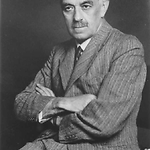Person
Agar, Wilfred Eade (1882 - 1951)
OBE CBE FRS

Wilfred Eade Agar
Details
- Born
- 27 April 1882
Wimbledon, England - Died
- 14 July 1951
Kew, Victoria, Australia - Occupation
- Zoologist
Summary
Wilfred Agar was Professor of Zoology at the University of Melbourne from 1919-1948 where he introduced the disciplines of cytology and genetics. A graduate of King's College, Cambridge, he demonstrated in zoology in Glasgow and spent some time in Paraguay prior to coming to Australia.
Details
Wilfred Agar obtained a Masters of Arts (zoology major) from Kings College, Cambridge. Upon completing his studies he had a brief stint in the Natural History section of the British Museum, then took up a demonstrating job with the Zoology Department of the University of Glasgow in 1904. This was the start of a distinguished career in teaching and research in genetics and cytology. His early work was on the embryology of the lungfishes Lepidosiren and Protopterus which led to a fellowship from King's Collage and funding from the Royal Society and the Balfour Fund, Cambridge for an exploration to the very inhospitable and inaccessible Gran Chaco in Paraguay.
In 1915 Agar's research was halted when he was enlisted to fight in World War I. He was made captain of the 5th Battalion and sent to Gallipoli (June 1915) and Egypt. While in Egypt (Alexandria) Agar become ill (enteric fever) and was sent back to England where he remained in army service until 1918. He migrated to Australia with his wife and children in 1919 to take up the Chair of Zoology at the University of Melbourne. This was a hectic role in the early days as Agar was the sole lecturer and main practical teacher. Agar eventually employed more staff to cover some of these duties so he could start up his research again. He was one of the first in Australia to discuss gene inheritance in cattle which lead to the introduction of applying genetic selection in animal breeding. During his 30 odd years at the University, Wilfred Agar rejected three offers to chair at British universities, he was a long-term council member, dean of the faculty of science twice, chair of the professorial board and councillor, then president, of the Royal Society of Victoria. During 1923-47 Agar and family lived in one of the original professors' houses, which he and his wife named 'Clyde'. His watercolour of Clyde' was used by the University of Melbourne Alumni and Development Unit for its 1997 Christmas card.
Chronology
- 1903
- Education - Bachelor of Arts (BA) in Zoology completed at University of Cambridge, UK
- 1904 - 1914
- Career position - Zoology Demonstrator at Glasgow University, Scotland
- 1907
- Education - Master of Arts (MA) in Zoology completed at the University of Cambridge, UK
- 1907
- Career event - Expedition to collect samples for cytology in Gran Chaco, Paraguay
- 1907 - 1913
- Award - Fellow of King's College Cambridge, UK
- 1908
- Life event - Married Elizabeth MacDonald in Glasgow
- 1914 - 1918
- Military service - Captain of the 5th Battalion with the Highland Light Infantry
- 1918 - 1919
- Career position - Zoology Demonstrator at Glasgow University, Scotland
- c. 1919
- Education - Doctor of Science (DSc), Glasgow University
- 1919 - 1948
- Career position - Professor of Zoology at the University of Melbourne
- 1920
- Career event - Cytology text book published in London
- 1921 -
- Career position - Foundation Councillor (Zoology), Australian National Research Council
- 1922
- Award - Doctor of Science (DSc), honoris causa, University of Melbourne
- 1924
- Career position - President, Section D (Zoology), Australasian Association for the Advancement of Science
- 1927 - 1928
- Career position - President of the Royal Society of Victoria
- 1930
- Career position - President, Section N (Physiology and Experimental Biology), Australasian Association for the Advancement of Science
- 1931 - 1934
- Career position - Chairman of the Professorial Board of the University of Melbourne
- 1939
- Award - Officer of the Order of the British Empire (OBE)
- 1943
- Career event - A Contribution to the Theory of the Living Organism published in Melbourne
- 1948
- Award - Commander of the Order of the British Empire (CBE)
Related entries
Children
Archival resources
Adolph Basser Library, Australian Academy of Science
Published resources
Encyclopedia of Australian Science and Innovation Exhibitions
- Exhibition Papers, A Bright Sparcs Exhibition, Australian Science Archives Project, 1997, http://www.asap.unimelb.edu.au/bsparcs/exhib/papers/exhib_papers.htm. Details
- Smith, Ailie, Adolph Basser Library Manuscript Collection, eScholarship Research Centre, 2012, http://www.eoas.info/basser_browse.html. Details
Book Sections
- Drummond, F. H., 'Agar, Wilfred Eade (1882-1951), zoologist' in Australian Dictionary of Biography, Bede Nairn and Geoffrey Serle, eds, vol. 7 (Melbourne: Melbourne University Press, 1979), pp. 16-17. http://www.adb.online.anu.edu.au/biogs/A070017b.htm. Details
Journal Articles
- Agar, W. E., 'Obituary: Dr. Georgina Sweet', Australian Journal of Science, 9 (1) (1946), 15. Details
- Kerr, J. G., 'Obituary: Professor W. E. Agar', Nature, 168 (1951). Details
- Tiegs, O. W., 'Obituary: Wilfred Eade Agar', Australian Journal of Science, 14 (2) (1951), 49. Details
Resources
- Wikidata, http://www.wikidata.org/entity/Q3568178. Details
- VIAF - Virtual International Authority File, OCLC, https://viaf.org/viaf/91227116. Details
- 'Agar, W E (1882-)', Trove, National Library of Australia, 2009, https://nla.gov.au/nla.party-458077. Details
- 'Awarded honorary DSc, 1922', Honorary degree holders, University of Melbourne, 2023, https://about.unimelb.edu.au/notable-alumni-staff/honorary-degree-holders. Details
Resource Sections
- 'Agar, Wilfred Eade - Ms 1', in Listing of Adolph Basser Library holdings, Australian Academy of Science, 1994, http://www.science.org.au/basser/manuscript-collection/ms001.html. Details
See also
- Hill, Dorothy, 'Edwin Sherbon Hills, 1906-1986', Historical Records of Australian Science, 7 (1) (1987), 79-95. https://doi.org/10.1071/HR9870710079. Details
- Mellor, D.P., 'Optical Munitions', Chapter 12 in Australia in the War of 1939-1945, Series 4: Civil, volume 5 'The Role of Science and Industry', Canberra: Australian War Memorial, 1958 (1958). http://www.asap.unimelb.edu.au/bsparcs/exhib/papers/mellor.htm. Details
Digital resources
McCarthy, G.J & Annette Alafaci
Created: 20 October 1993, Last modified: 16 November 2022
- Foundation Supporter - Royal Society of Victoria
